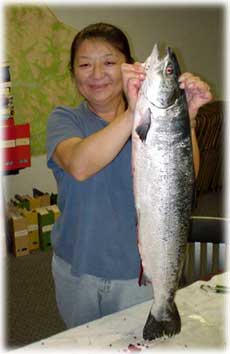 by Sonya Senkowsky August 26, 2004
At fish farms hundreds of miles away, along the coasts of British Columbia and Washington state, Atlantic salmon raised in ocean pens are a lucrative cash crop. But some have escaped and made their way into Alaska streams, where they are unwanted invaders. So far, Atlantic salmon don't seem to have established new populations here. But Doug Mecum, the director of Alaska Department of Fish and Game's Commercial Fisheries Division, says the fact that some farmed salmon have been found breeding successfully in creeks in Washington and British Columbia is cause for concern. Mecum said, "We have observed that they actually can successfully reproduce, so that's one of the reasons why we're concerned." Scientists believe farmed Atlantic salmon are incapable of interbreeding with Pacific salmon-even in a lab, that's a match that's been nearly impossible to make. But, like any nuisance species, Mecum says, the invaders could cause other trouble for Alaska's wild stocks by competing for resources or transmitting disease. "It's kind of like oil and water. Once it gets in, it's really tough to get it out. And that's been the history with aquatic nuisance species or invasive species all over the world.... Once they get established, it's extremely difficult to get rid of them, said Mecum. Over the past decade, hundreds of thousands of fish have escaped British Columbia and Washington state fish farms. But only in the last six years did they begin showing up in Alaska's freshwater streams. The first documented interloper was caught in Ward Creek near Ketchikan in August 1998, by sport fishermen who contacted Fish and Game officials, says Mecum. Mecum said, "They caught a fish and it looked strange so they thought, 'What is this?' and they brought it in. We've also had a number of reports from people who said, 'You know, I caught this weird fish and I didn't know if it's an Atlantic salmon or not.' So, obviously, we think there are more of these Atlantic salmon getting into our streams." Fish and Game biologists still think it's highly unlikely that Atlantic salmon raised on farms hundreds of miles away could win the battle against wild salmon for resources and habitat. Experiments to purposely introduce them into the wild have not been very successful. Then again, biologists are alert to the possibility that nature could surprise them, says Mecum. Mecum said, "We don't believe that there's a real high likelihood of Atlantic salmon becoming established in Alaskan waters, but we want to make sure that we're vigilant, and we want to look and keep some kind of a monitoring program in place." To maintain their vigil against Atlantics, the Department of Fish and Game is sampling commercial catches, educating fishermen and processors about what the Atlantics look like and, Mecum says, even suiting up in wetsuits, snorkels and masks to get an up-close look at what fish are in the water. Mecum said, "The snorkel survey just allows you to cover a lot of ground. You can float down the stream and you can see the juvenile fish holding there, and if you're trained in how to identify them, you can see if it's an Atlantic salmon, or a coho or a steelhead. You The Department of Fish and Game asks that fishermen turn in any unusual-looking fish that seem to fit the description of an Atlantic salmon. Mecum said, "What we want people to do is, that if they think they have one, and they're reasonably confident of that, that they go ahead and bring it in to us as opposed to let it go or eat it." Fishermen should freeze the fish whole. If the fish does turn out to be an Atlantic salmon, Mecum says, Department of Fish and Game scientists will want to determine the sexual maturity of the fish, inspect its stomach contents, and do a genetic analysis. If you'd like to learn more
about farmed salmon interactions with wild salmon, swim on over
to our Web site at www.asjnews.org. This is Arctic Science Journeys
Radio, a production of the Alaska Sea Grant Program at the University
of Alaska Fairbanks School of Fisheries and Ocean Sciences. I'm
Sonya Senkowsky.
Story courtesy Arctic Science Journeys. Arctic Science Journeys is produced by the Alaska Sea Grant College Program and the University of Alaska Fairbanks.
Related story & photograph:
|
|||
